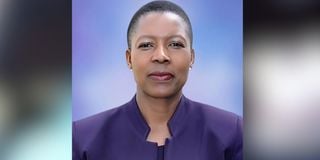Women breaking barriers in Kenya’s justice sector

Ms Dorcas Oduor. She has been nominated the first female Attorney General.
What you need to know:
- Dorcas Oduor would be the first woman to hold the office Attorney General.
- Increased presence of women in senior positions deals a body blow to the problem of loneliness among peers.
There is palpable excitement in gender quarters following the nomination of Dorcas Oduor to become the next Attorney General of Kenya. This is based on several factors.
She would be the first woman to hold such an office. She is professionally qualified for the job and has formidable experience. She would also be the first person from a specific ethnic group to occupy the office. This means that she would be breaking gender, ethnic, political and professional fences.
Her prospective appointment would be a fulfilment of Article 7 of the Convention on the Elimination of all forms of Discrimination against Women, which requires States Parties, Kenya being one, to ensure that women are included in all levels of government and public life.
Increased presence of women in senior positions deals a body blow to the problem of loneliness among peers, recognised in Rosabeth Moss Kanter’s Critical Mass Theory as a cause of professional isolation, sabotage and frustration.
If she is approved by Parliament, Oduor would be joining an increasing number of women holding senior positions in the justice sector. Already, Kenya has the first female chief justice, the second female deputy chief justice and a supreme court that is almost 50 per cent gender balanced.
Statistics show that the Judiciary is the best performing arm of the government in terms of gender balance and meeting the constitutional threshold that not more than two thirds of office holders should be of one sex.
The Economic Survey 2023 shows that in both 2021 and 2022, three (42.9 per cent) of the seven Supreme Court judges were women. Of the 19 Court of Appeal judges, 10 (52.6 per cent) were women in 2022, overtaking 2021 when they constituted 50 per cent. There were 79 (52.3 per cent) women out of 151 of High Court judges in 2022. Women also outnumbered men among magistrates at 298 (55 per cent) out of 542.
It is only under kadhis that they did not feature, given the religious dictates on who can occupy such an office, a matter that should be interrogated given that there are many Moslem women serving in the Judiciary in other capacities and the fact that Kenya is constitutionally a secular state. Among practising lawyers, men edge women out at 7,425 against 6,481 (46.8 per cent) of the 13,908 advocates. This pattern has been consistent since 2016.
The situation simply means that women have an equal, if not better, chance of rising through the ranks if promotions in the sector are done fairly. The more interesting question from which to learn about eradicating gender imbalance is why there are so many women in Kenya’s legal profession and justice sector in the first place.
One cannot join the legal professional without pursuing a relevant course. The 2020 publication Women’s professional participation in Kenya’s justice sector: Barriers and pathways, by the International Development Law Organisation, records that the ratio of females to males enrolled in law schools across Kenyan universities in 2019 was almost on a par “with some schools having more girls in class”.
In this case, the proportions of female law students were 50 per cent at the University of Nairobi and Egerton, 60 per cent at Strathmore and 54 per cent at Moi. “Between 2011 and 2016”, it states, “the enrolment ratio at the Kenya School of Law was almost 50:50”.
Is it then a surprise that women are highly visible in the sector? In fact, the lesson is that saturation of a subject by female students automatically results in their progression into the related career upon graduation.
Thus, if we are to achieve gender balance in careers, a good starting point is enrolment of girls into relevant subjects right from secondary school. This lesson should apply to science, technology, mathematics and engineering, in which women are fewer.
Law has always been a competitive university course requiring excellence in secondary school examinations. That many female students join the course is a testimony that they perform well in the arts, which undeniably explains their substantial presence and progression in this particular profession and the justice sector.
It may also be argued that girls are motivated to pursue law by the presence of their kind in the profession. Anecdotal evidence shows that many girls have been inspired to set their eyes on high positions, including the presidency, by the mere fact that the chief justice is a woman. This demonstrates the profound influence of role modelling and the need to leverage it through structured and sustained mentorship by luminary women.
As the country waits with bated breath to see if Oduor will be approved, the next question worth examining is whether, from a substantive rather than descriptive perspective, it really matters that a woman is an attorney general. Watch this space.
The writer is a lecturer in Gender and Development Studies at South Eastern Kenya University ([email protected]).





